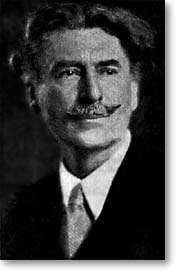|

Ernest Thompson Seton
Ernest Thompson Seton was born in South Shields, Durham, England but emigrated
to Canada with his family at the age of 6. His original name was Ernest Seton
Thompson.
His sketches as a youth won awards. Consequently, he was sent to study art in
London at The Royal Academy School of Painting and Sculpture. Late he went to
Paris for further study. In 1881, he became the Naturalist for the government of
Manitoba.
The Ladies Home Journal magazine asked him to write a series on woodcraft for
boys. The first article appeared in May, 1902. On the first day of July in
1902, he founded the Woodcraft Indians. He wrote a book, The Birchbark Rolls
of the Woodcraft Indians as a guide for the program. This book was sent to
Baden-Powell in July of 1906 as a precursor to Seton's visit to England for a
series of fall lectures. On October 30th, the two men met at the Savoy Hotel..
He was Chief Scout from 1910 to 1915. The original 1910 handook included 50
pages from Baden-Powell and 100 pages of Seton's writings.
Seton developed a plan for incorporating younger boys into Scouting in 1911.
Called "The Cubs of America", it used the bear cub as its symbol. Disagreements
among Scouting's founders over the value of the new program caused it to be set
aside.
Seton had a falling out with James West and left the movement in 1915. He
disagreed with the military style set by Baden-Powell and West. Seton then
founded the Woodcraft League of America. He later came back to help organize
Cubbing for the younger boys.
Seton received the seventh Silver Buffalo award in 1926; the first year it was
offered.
| 
